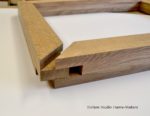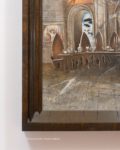In framing Karima Cammell‘s work for her solo show “High Water” here at the Gallery (check out today’s great review in Berkeleyside), the recurring historical subject matter pushed me to explore a  kind of frame construction frequently seen on medieval and early Renaissance work. I call them “sill frames” because their distinguishing feature is the bottom horizontal member which, instead of being a mirror image of the molding at the top of the frame, is made to resemble a threshold or window sill. We used three sill frames in the show. In this post I’m introducing this type of frame with historical examples from an incredible online resource, as well as sharing a few process shots and details of the frame for Karima’s 18″ x 24″ egg tempera painting, “Atlantis,” below. I’ll post on the other two pieces in the show later, as well as share my less technical discoveries—which have led to nothing less than an epiphany for me—regarding the surprisingly profound significance of sill frames, certainly in relation to the show but also, in fact, for the art of the picture frame.
kind of frame construction frequently seen on medieval and early Renaissance work. I call them “sill frames” because their distinguishing feature is the bottom horizontal member which, instead of being a mirror image of the molding at the top of the frame, is made to resemble a threshold or window sill. We used three sill frames in the show. In this post I’m introducing this type of frame with historical examples from an incredible online resource, as well as sharing a few process shots and details of the frame for Karima’s 18″ x 24″ egg tempera painting, “Atlantis,” below. I’ll post on the other two pieces in the show later, as well as share my less technical discoveries—which have led to nothing less than an epiphany for me—regarding the surprisingly profound significance of sill frames, certainly in relation to the show but also, in fact, for the art of the picture frame.

“Atlantis,” egg tempera on linden board, 18″ x 24″ in 2-1/2″ sill frame in quartersawn white oak (Dark Medieval Oak stain).
Some history
I’ve admired Northern Renaissance (especiallly Flemish Primitive) sill frames for a long time. (One famous example you may recognize and that I’ve posted about is Hans Memling’s “Christ Giving His Blessing,” at right.) Karima’s show was the perfect opportunity to try my hand at them. Research led me to an incredible treasure trove of examples—a 734-page online book dryly titled Frames and Supports in 15th and 16th Century Southern Netherlandish Painting, by Hélène Verougstraete (2015, Royal Institute for Cultural Heritage, Brussels). Written for painting conservators tasked with treating work of that period, it is also a frame-maker’s dream—a gold mine of excellent high-resolution photographs of paintings in their frames. (It’s shocking how frequently paintings are shown in books with their frames cropped out—even frames made by or in cooperation with the painter, or in any case original to the painting). But just as exciting for me is the exhaustive research on joinery [“We have observed 38 different joints, which we have classified into 6 families: mortise and tenon joints, dovetail joints, slotted joints (also known as bridle or open tenon or tongue and fork), lap joints, joints with inserts (splined or keyed joints), end-to-end joints…”; you get the idea], and loads of clear diagrams of all those joints and how the frames and supports were constructed. Not all, but the vast majority of the paintings in the book are in sill frames, suggesting that in that region (today’s Low Countries) it was the dominant type of frame for over a century.
Examples from “Frames and Supports…”—
Below is a typical page from Frames and Supports in 15th and 16th Century Southern Netherlandish Painting. This one shows an anonymous “Adoration of the Magi” from Bruges, ca. 1510. The joinery in the diagrams at the bottom right are what I used for the frame for “Atlantis.” Here are more pages and details from the book. What becomes abundantly clear is that these frames and supports were real works of craftsmanship.
Here are more pages and details from the book. What becomes abundantly clear is that these frames and supports were real works of craftsmanship.
Making the sill frame for “Atlantis”—
So, armed with my research, I rolled up my sleeves and went to work.
- Mortise and tenon joint for the sill (before profiling the side)
- The top left corner joint
- The top with joints cut, but before profiling
- Four sides with joints and profiles cut
- Left sill joint fit
- The left sill joint finished
Details of the finished frame—
Note how I extended the cracks in the floor by carving them into the sill, using that key feature of the frame in the same fashion Memling did in the painting above… But that gets in to the significance of sill frames and the wonderful lessons they hold for us for what a picture frame is—which I’m saving for another post.
Come see “Atlantis” in person! “High Water: Works by Karima Cammell” is on now and has just been extended through November 5 so that we can be included in Festive First Friday on Fourth! And again, you can read Gabrielle Selz’s excellent review in Berkeleyside, here.
Read “Sill Frames—II: Framing Karima Cammell’s ‘Aqua Alta'”…
« Back to Blog















The application of scholarship; the execution of super-tight joints; and the custom hand-carving—all very impressive!
This series of pieces is a creativity-inducing collaboration, each piece one-of-a-kind.
How kind! Many thanks! Yes, the collaboration was wonderful. Karima’s a dream to work for—and with!